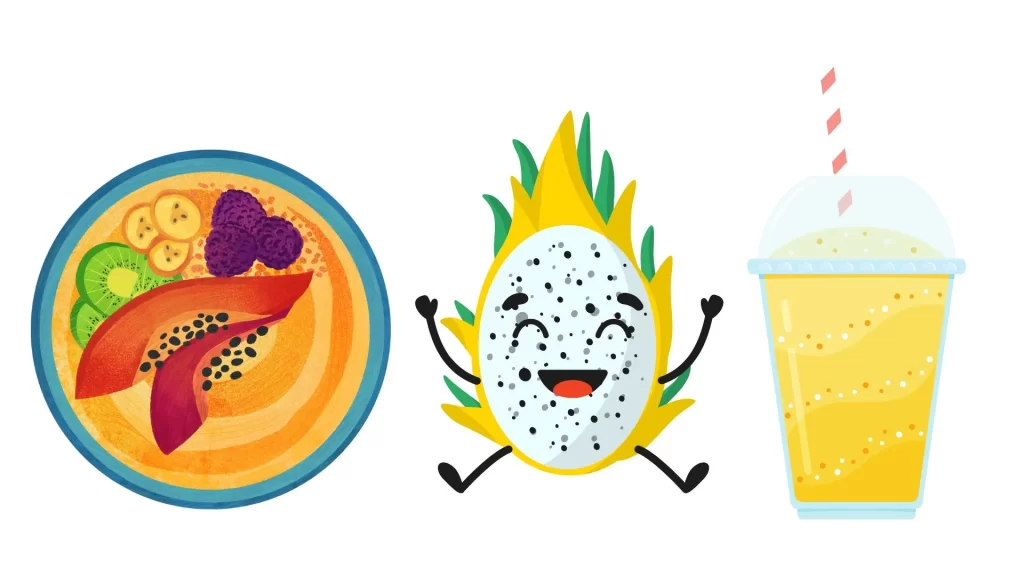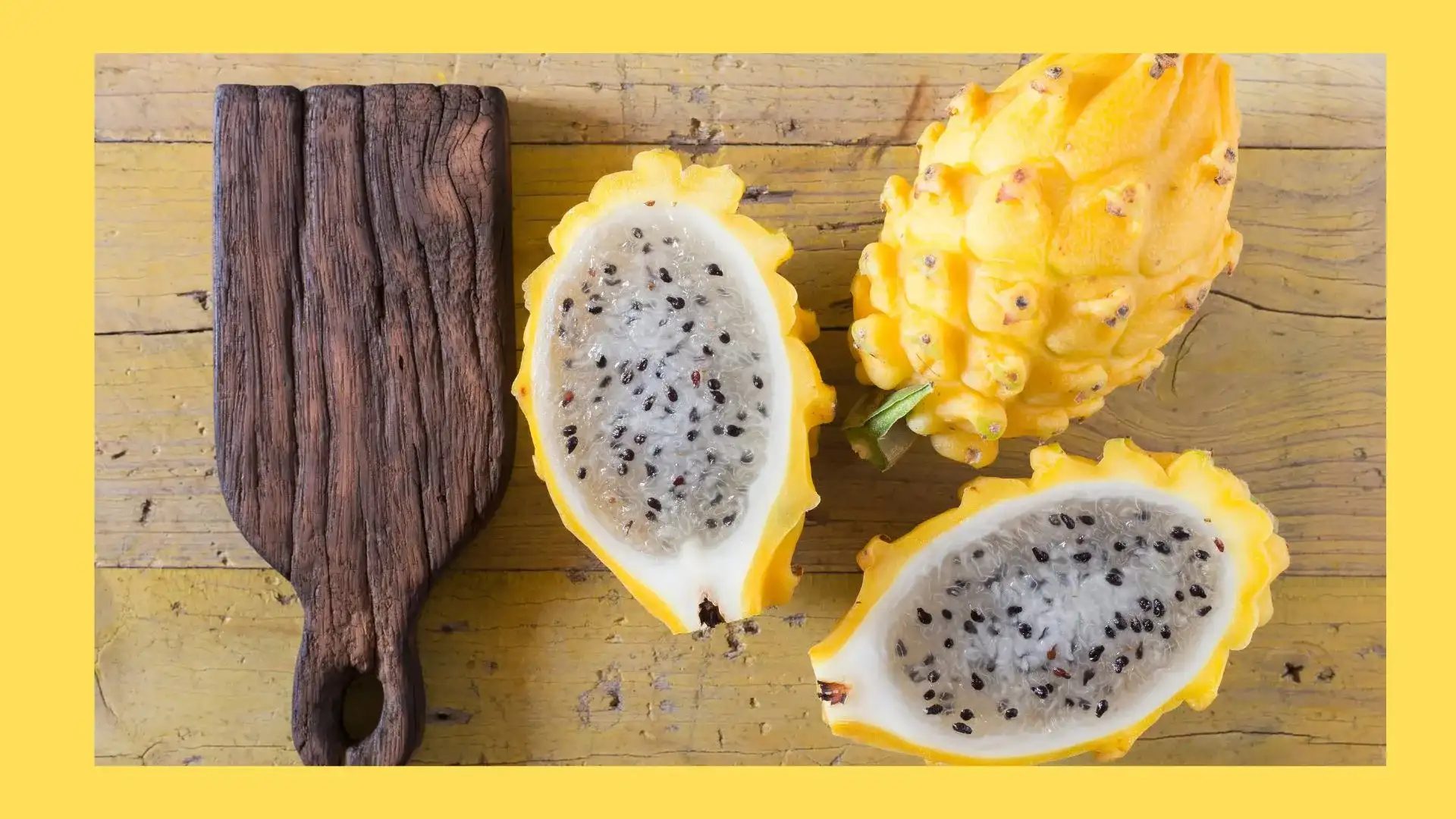Yellow dragon fruit or Yellow Pitaya – Let’s explore its health benefits and why it is considered the nutritional powerhouse. Check out the ways to enjoy this delicious culinary sunshine delight!
Dragon Fruit or Pitaya - A Tropical Wonder
Dragon fruit, also known as pitaya, belongs to the Cactaceae family (genus Hylocereus). It is a captivating tropical fruit that has gained popularity in recent years due to its vibrant appearance and numerous health benefits. It is considered a nutritional powerhouse with essential nutrients, which include vitamins, minerals, antioxidants, and fiber, and health benefits such as improved digestion, enhanced immune function, and potential anti-inflammatory properties.
Other common names of Dragon fruit are pitahaya, dragon pearl fruit, night-blooming cereus, strawberry pear, and Cinderella plant.
Selenicereus megalanthus or Hylocereus megalanthus, called ‘Pitahaya’, is commonly known as ‘yellow dragon fruit’, or ‘yellow pitaya’. In this blog post, we will explore the fascinating world of dragon fruit, its origins, unique characteristics, nutritional value and benefits, and ways to enjoy this delicious fruit and incorporate it into your culinary adventures.
Origin of Dragon Fruit
The origin of dragon fruit can be traced back to Central America, specifically the tropical rainforests of Mexico, Costa Rica, and Nicaragua (1). The fruit is believed to have been cultivated and consumed by indigenous communities in these regions for centuries.
The exact origins of dragon fruit are still a subject of debate among researchers and botanists. However, it is widely believed that the fruit’s natural range extends from Central America to South America. It is also found in parts of Southeast Asia, particularly Vietnam, where it is known as “thanh long.”
Dragon fruit was introduced to other parts of the world through trade and exploration. In the 19th century, it made its way to other tropical regions, including countries like the Philippines, Thailand, Malaysia, and Indonesia.
Over time, dragon fruit gained popularity and began to be cultivated commercially in various countries with suitable climates.
Today, it is grown and consumed in many parts of the world, including the United States, Australia, Israel, and several countries in Europe. The yellow dragon fruit or the yellow pitaya is native to South America and is grown commercially for its yellow fruit.
Dragon Fruit Varieties/ Types
Through cultivation and selective breeding, different varieties of dragon fruit have emerged, each with its unique characteristics and colors, such as the more common red-fleshed and white-fleshed varieties, as well as the lesser-known yellow dragon fruit and pink-fleshed varieties.
Further, the yellow-skinned fruit of S. megalanthus has thorns, unlike the other dragon fruit varieties. On the basis of the color of the pulp and peel, Dragon fruit can be classified as (2):
1. White Pulp with Pink Peel Dragon Fruit (Hylocereus undatus)
2. Red Pulp with Pink Peel Pitaya (Hylocereus polyrhizus)
3. White Pulp with Yellow Skin (Hylocereus megulanthus) (Yellow dragon fruit or Yellow Pitaya)
Yellow Dragon Fruit Health Benefits
Dragon fruit, also known as pitaya, has indeed been used for its potential medicinal properties since ancient times. The fruit and the flower have been used for blood sugar-lowering activity, as a disinfectant for wounds and for healing, as a diuretic, for dysentery, and for tumor dissolution.
While it is important to note that scientific research is ongoing in this area, dragon fruit does contain several bioactive compounds that may offer certain health benefits. In fact, several scientific studies show multiple health benefits of Dragon Fruit. Researchers have shown the antioxidant, analgesic, antidiabetic, anti-inflammatory, and anticancer potential of dragon fruit. Further, dragon fruit has been demonstrated to be cardioprotective, hepato (liver) protective, and neuroprotective.
A recent review published in 2023 on dragon fruit observed that the above benefits were mainly demonstrated in cell culture or animal studies. However, only 4-5 clinical studies were available, and that too, the majority of the studies have been carried out on H. polyrhizus (3). There are only very few studies available on other dragon fruit varieties.
The Yellow Dragon Fruit Or Yellow Pitaya - What we know so far
Yellow dragon fruit, also known as Yellow Pitaya, is a captivating and lesser-known variety of dragon fruit. It is a medium-sized fruit, weighing 180-250g. With its vibrant color and unique flavor, this tropical fruit has gained popularity among fruit enthusiasts. It is smaller in size than red pitaya fruit. It tastes sweeter and juicier than the red variety.
Yellow Dragon Fruit or Yellow Pitaya - A Nutritional Powerhouse
Nutrition-wise, yellow pitaya is a potential source of betaxanthins, beta-carotene, vitamin E, and lycopene, which have been widely used as a yellow colorant in beverages and yogurts, etc. Further, a comparative study on the varieties of dragon fruit reported that yellow pitaya had the highest gallic acid and quercetin levels, and lowest rutoside, beta-cyanins, and total polyphenols (2). Yellow Dragon fruit is a good source of magnesium, phosphorus, potassium, dietary fiber, calcium, and protein. In addition, it contains small amounts of iron, vitamins A and C, and niacin. The pitaya peel from all varieties contains high levels of betacyanin, an antioxidant substance with antimicrobial activity.
Health Benefits of Yellow Pitaya or Dragon Fruit
Gut Health
The polyphenols present in the dragon fruit can stimulate the growth of health-boosting microbes, including Lactobacillus, and Bifidobacterium, in the human gut. It can also inhibit the growth of unhealthy disease-causing microbes, such as Escherichia coli.
Lowers Blood Glucose Levels
The polyphenols present in yellow dragon fruit can inhibit α-amylase and α-glucosidase activity, hence showing antidiabetic effects.
Free Radical Scavenging Activity
Polyphenols are powerful scavengers of free radicals. This strong antioxidant property can help prevent chronic diseases. Further, high levels of quercetin can also neutralize harmful free radicals in the body and protect cells from oxidative stress. Quercetin present in yellow dragon fruit can also exhibit anti-inflammatory properties.
Cardiovascular Health
The quercetin present in yellow dragon fruit can show cardiovascular benefits. It may help lower blood pressure, reduce LDL cholesterol levels, improve blood vessel function, and reduce the risk of heart disease.
Anticancer Potential
Some studies also suggest that the bioactive constituents present in Pitaya fruit can help prevent cancer.
Source of Vitamin A
Dragon fruits have high carotenoid content and are an excellent source of provitamin A. It was reported that 200 g of this fruit can meet the daily vitamin A requirement for adults (4).
Stimulate Immune System
Vitamin C and carotenoids present in the fruit are strong antioxidants that can protect your white blood cells from damage and show immune-boosting effects.

Yellow Dragon Fruit - Culinary Inspirations
Enjoy It Fresh
Yellow dragon fruit can be consumed raw as well as cooked. One can relish yellow dragon fruit in its raw form, by slicing it, scooping it out, or combining it with other fruits in salads.
Smoothies & Beverages
The mouthwatering yellow dragon fruit can be added to smoothies or can be incorporated into refreshing juices, mocktails, or even cocktails.
Culinary Creations
The versatile yellow dragon fruit can be used as yellow dragon fruit sorbet or yellow dragon fruit salsa, or one can incorporate it into desserts like tarts or cakes.
Conclusion
Yellow dragon fruit or pitaya offers a delightful twist to the well-known dragon fruit family, bringing its own vibrant color and distinct flavor to the table. It is a visual delight and a nutritious and versatile fruit that can be enjoyed in various ways. Whether you want to savor, its unique taste, reap its health benefits, or embark on a gardening adventure, yellow dragon fruit is a fascinating addition to your culinary and horticultural explorations. However, there are limited scientific studies available on yellow pitaya, and most of them have been carried out on the red variety. Certainly, we need more preclinical and clinical data on Yellow Dragon fruit to confirm the benefits of its bioactive constituents.
With its nutritional benefits and culinary versatility, this tropical gem is definitely worth exploring. So, embrace the sunshine charm of yellow dragon fruit, experiment with its flavors, and let it add a tropical touch to your culinary endeavors.
Sources
1. https://www.mdpi.com/1420-3049/27/3/808
2. https://www.ncbi.nlm.nih.gov/pmc/articles/PMC8618204/
3. https://pubmed.ncbi.nlm.nih.gov/36678789/
4. https://www.ncbi.nlm.nih.gov/pmc/articles/PMC7859243/
Related Posts



9 Ways To Sneak Some Extra Fruits And Vegetables In Your Family’s Diet

Geriatric Nutrition – The Science of Nutrition for the Elderly

Importance of Nutrition for Children and Kids Little Tummies


